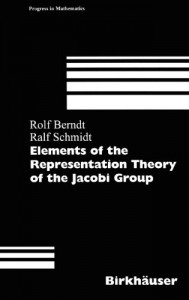The Jacobi group is a semidirect product of a symplectic group with a Heisenberg group. It is an important example for a non-reductive group and sets the frame within which to treat theta functions as well as elliptic functions -- in particular, the universal elliptic curve. This text gathers for the first time material from the representation theory of this group in both local (archimedean and non-archimedean) cases and in the global number field case. Via a bridge to Waldspurger's theory for the metaplectic group, complete classification theorems for irreducible representations are obtained. Further topics include differential operators, Whittaker models, Hecke operators, spherical representations and theta functions. The global theory is aimed at the correspondence between automorphic representations and Jacobi forms. Incorporating results of the authors' original research, this exposition is meant for researchers and graduate students interested in algebraic groups and number theory, in particular, modular and automorphic forms. Series: Progress in Mathematics, Vol. 163 Contents: Introduction 1 The Jacobi Group 1.1 Definition of G J 1.2 G J as an algebraic group 1.3 The Lie algebra of G J 1.4 G J over the reals 2 Basic representation theory of the Jacobi group 2.1 Induced representations 2.2 The Schrodinger representation 2.3 Mackey's method for semidirect products 2.4 Representations of G J with trivial central character 2.5 The Schrodinger-Weil representation 2.6 Representations of G J with non-trivial central character 3 Local representations: The real case 3.1 Representations of g J C 3.2 Models for infinitesimal representations and unitarizability 3.3 Representations induced from B J 3.4 Representations induced from K J and the automorphic factor 3.5 Differential operators on X = H x C 3.6 Representations induced from N J and Whittaker models 4 The space L 2 (G J G J (R) ) and its decomposition 4.1 Jacobi forms and more general automorphic forms 4.2 The cusp condition for G J ( R ) 4.3 The discrete part and the duality theorem 4.4 The continuous part 5 Local representations: The p -adic case 5.1 Smooth and admissible representations 5.2 Whittaker models for the Schrodinger-Weil representation 5.3 Representations of the metaplectic group 5.4 Induced representations 5.5 Supercuspidal representations 5.6 Intertwining operators 5.7 Whittaker models 5.8 Summary and Classification 5.9 Unitary representations 6 Spherical representations 6.1 The Hecke algebra of the Jacobi group 6.2 Structure of the Hecke algebra in the good case 6.3 Spherical representations in the good case 6.4 Spherical Whittaker functions 6.5 Local factors and spherical dual 6.6 The Eichler-Zagier operators 7 Global considerations 7.1 Adelization of G J 7.2 The global Schrodinger-Weil representation 7.3 Automorphic representations 7.4 Lifting of Jacobi forms 7.5 The representation corresponding to a Jacobi form
Elements of the representation theory of the jacob
Sobre
Talvez você seja redirecionado para outro site












